Jim Aikin (ed.), Software Synthesizers
Jim Aikin (ed.), Power Tools for Synthesizer Programming
Tim Barr, Techno: The Rough Guide
Tim Barr, Kraftwerk: From Dusseldorf to the Future (with Love)
Brian Belle-Fortune, All Crew Muss Big Up: Journeys Through Jungle Drum & Bass Culture
Sean Bidder, House: The Rough Guide
Pascal Bussy, Kraftwerk: Man, Machine and Music
Pascal Bussy and Andy Hall, The Can Book
David Byrne, How Music Works
John Cage, A Year from Monday
Michel Chion, Audio-Vision: Sound on Screen
Chris Cutler, File Under Popular
Kodwo Eshun, More Brilliant than the Sun: Adventures in Sonic Fiction
Bruce Gerrish, Remix: The Electronic Music Explosion
Peter Hammill, Killers, Angels, Refugees
Eric Hawkins, The Complete Guide to Remixing
Chris Kempster (ed.), History of House
Colin Larkin, The Virgin Encyclopedia of Dance Music
Simon Reynolds, Generation Ecstasy
Simon Reynolds, Retromania
Curtis Roads, Microsound
Ira L. Robbins (ed.), The Trouser Press Guide to New Wave Records
Mark Roberts, Rhythm Programming
David Rosenboom, Biofeedback and the Arts: Results of Early Experiments
R. Murray Schafer, The Soundscape
Peter Shapiro, Drum'n'bass: The Rough Guide
Peter Shapiro (ed.), Modulations: A History of Electronic Music: Throbbing Words on Sound
Dan Sicko, Techno Rebels: The Renegades of Electronic Funk
Rick Snoman, The Dance Music Manual: Tools, Toys and Techniques
Allen Strange, Electronic Music: Systems, Techniques, and Controls (2nd ed.)
David Toop, Rap Attack #3
David Toop, Ocean of Sound: Aether Talk, Ambient Sound and Imaginary Worlds
Nigel Trevena, Lou Reed & The Velvets
Tony Verderosa, The Techno Primer: The Essential Reference for Loop-Based Musical Styles
David Walley, No Commercial Potential: The Saga of Frank Zappa & The Mothers of Invention (original and updated editions)
Marc Weidenbaum, Selected Ambient Works Volume II (33 1/3 series)
December 2020
"March of the Covids" screening at ICOSA Gallery, Austin, TX, documentation
As promised, I am posting some post-show documentation of St Celfer's performance at ICOSA Collective, Austin, TX, on December 12, 2020. The images came from the gallery and other sources. First, a phone shot (rotated to normal orientation) depicting a laptop and large screen monitor streaming the video of the St Celfer/Tom Moody release eleven tracks, a compilation which includes St Celfer's song "March of the Covids" (https://youtu.be/e_zaeQ-SpzQ):
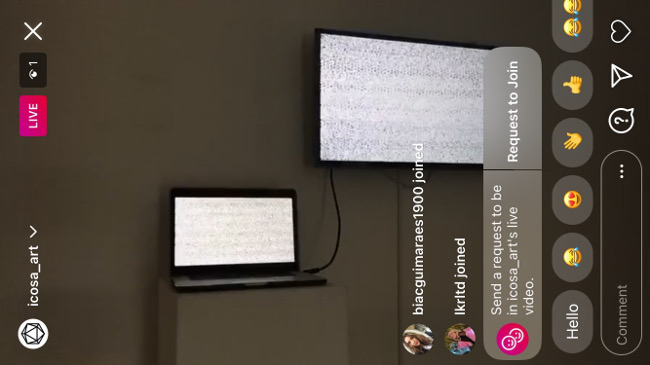
Next, a couple of pics from the gallery showing the scale and space of the artwork. There were two viewing stations streaming the video:
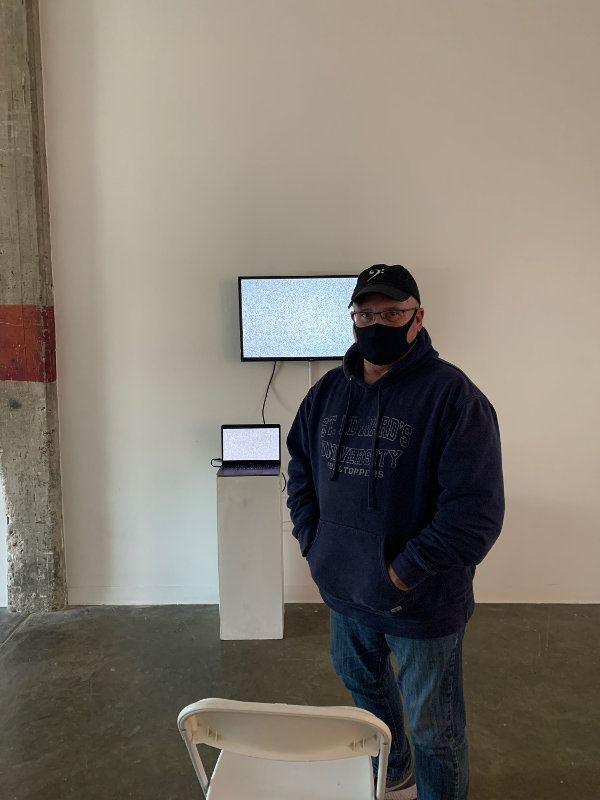 |
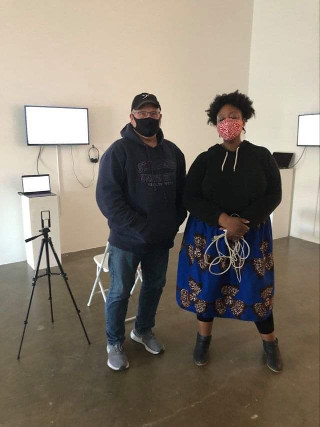 |
And last, "social media reactions" including a blurry close-up and sound excerpt from the video:
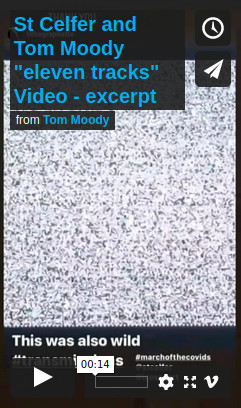
St Celfer and Tom Moody "eleven tracks" Video - excerpt from Tom Moody on Vimeo.
The video as it appeared playing on a device:
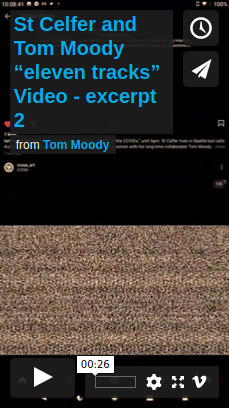
St Celfer and Tom Moody “eleven tracks” Video - excerpt 2 from Tom Moody on Vimeo.
And the video playing in the gallery:
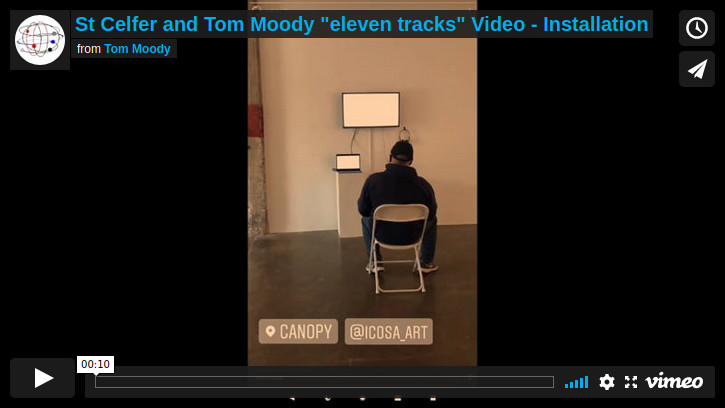
St Celfer and Tom Moody "eleven tracks" Video - Installation from Tom Moody on Vimeo.
[Note: embedded players -- which I basically hate -- are replaced with links when they move off the blog front page]
around the web: computers-R-stupid edition
• Pepe Escobar on AI predictions in the 1980s.
• Maciej Ceglowski on The Website Obesity Crisis (hat tip John Romero). Published 5 years ago and sites have only gotten fatter and slower, tommoody.us included. One of my New Year resolutions is getting a WordPress theme that doesn't use fonts from Eric Schmidt's company (how did that happen?). The font files aren't that large, I don't think, but there's a slight hang while they load that's annoying. I also don't think a page like mine needs all these damn scripts. I do remove embeds once they drop off the front page, because I hate embeds.
st celfer on zoom
St Celfer (aka John Parker) discusses his recent art and music via Zoom:
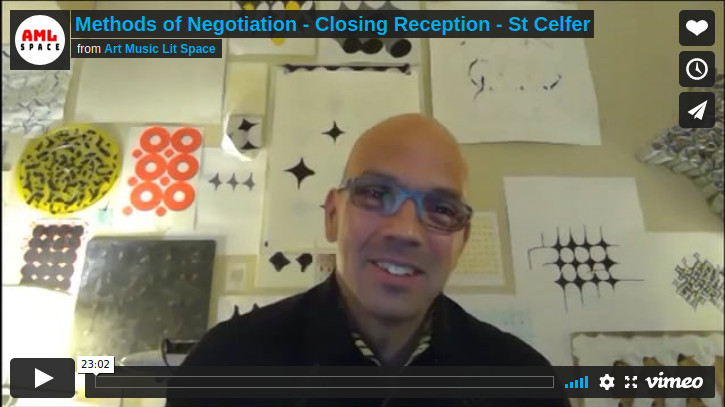
Methods of Negotiation - Closing Reception - St Celfer from Art Music Lit Space on Vimeo.
Art Music Lit Space is a post-post-internet virtual community seeking to "probe the chasm together so suddenly imposed by social distancing measures" by providing a "locus for artists, curators, writers, lookers, listeners, feelers and thinkers to show, share, and connect despite the nearly global closure of physical exhibition spaces such as studios, galleries, basements, museums, schools, art fairs, fields, etc."
The performance of St Celfer's musical piece "March of the Covids" (featured on our recent collaboration and on St Celfer's Bandcamp page) was realized (or rather, virtualized) by Art Music Lit Space as an embedded sound clip on a blog page; the Vimeo above is more in the nature of post-show documentation.
When the music was performed last week in Austin (described in an earlier post) it was displayed as a YouTube video with an abstract video component (and encoded bonus content for YouTube users), on multiple large screen monitors with speakers behind each screen.
"Post-post-internet" is a joke, of course. "Post-internet" was a brief, curator-driven quasi-movement that dealt with art-with-internet-content being shown in galleries. It was a bizarre name because of course the internet never ended and in fact most gallery activity didn't exist in people's consciousnesses until it appeared there. Covid simply takes the gallery out of the loop. Yet, as we saw in Austin, some physical spaces still exist (and in Austin they had about twenty mask-wearing visitors). Once I have documentation of people walking around the room while the video plays, I'll post it, and that will be the so-called post-internet manifestation. [Update: Some documentation of the event is here.]
Kodwo Eshun on abstraction
Found a PDF of Christopher Cox's 2014 interview with writer Kodwo Eshun, making a case for a hermetic practice, despite the current art world's hatred of abstraction lacking in obvious identity signifiers. Excerpts are below.
Christopher Cox: Yet you clearly don’t aim to wrap it all up neatly. As you mentioned earlier, there’s a hermetic -- even mystical -- tendency in your work that resists decoding and competes with the hermeneutic tendency to fully understand or “unzip.”
Kodwo Eshun: Yeah, the sense of initiation, the sense that the work is initiating you into an enigma so that you become something like a disciple. So, there is something occult.
CC: Not just a reader or interpreter, but a disciple?
KE: Yes. You become part of it, which implies that you’re won over by it and that you too will go out and somehow proselytize on behalf of the work and carry it with you so that you’re now a kind of card-carrying disciple of this enigmatic experience that you’ve had. You haven’t decoded it. You’ve accepted that you can’t decode it and you’ve enjoyed that process will take it with you. This initiation is something I really enjoy. Certain kinds of audiovisual experiences are really good at doing that. Certain kinds of films have this capacity to turn you into disciples of them; and this is also the strongest feeling of Drexciyan music itself. So, there’s a kind of affirmative dimension to mystification. “Mystification” sounds obfuscatory, like you’re mystifying for the sake of it. But I’m interested in “mystification” in the sense of what Marshall McLuhan calls“participation mystique.” [The phrase is originally from Lucien Lévy-Bruhl, How Natives Think (1910), trans. Lilian A. Clare (London: Allen & Unwin, 1926).] If an artistic experience is really working, it’s working through this level of you finding yourself participating in a mystery without quite realizing how you got there. The music I love has that dimension.
CC: It has to solicit you, in a way.
And more:
Kodwo Eshun: There’s a curator in the States, Valerie Cassel Oliver, who’s been excavating African-American abstraction. It’s not that it was buried, but for different reasons, certain abstractionists perennially complicate an easy read. Whether it’s Norman Lewis or Fred Eversley, these figures are not racially readable. That’s all it takes. As soon as the work throws up a dimension of optical fugitivity, in other words, as soon as the work cannot immediately be read as belonging to what people recognize is African-American legibility, then suddenly it disappears, whereas actually it is exactly that work that is most compelling precisely because it blocks legibility so you can’t easily read it in terms of the identity of the person who is making it. You have to do more work. You have to think of all the other things that the work might be about, as well as the identity of the artist. So, with people like Charles Gaines, the African-American Fluxus artist Benjamin Patterson, all these artists, the complexity of their work is not an easy read. So, they tend not to be named when we talk about Afrofuturism. But actually, if they’re not Afrofuturists, I don’t know who is.
